Abstract
OBJECTIVE--To measure the unmet need of patients with regular urinary incontinence (incontinence twice or more a month) treatable by a nurse. DESIGN--Self completed postal questionnaire and randomised controlled trial of assessment and intervention by a nurse. SETTING--One urban and one rural general practice in Somerset. SUBJECTS--7300 adults randomly selected from 10,300 aged 35 and over on the combined practice lists. 515 women and 185 men with regular incontinence were offered assessment and treatment, of whom 134 women and 49 men had no intervention for three months (historical controls). They then joined the assessment and treatment programme. INTERVENTION--Four sessions of pelvic floor exercises and bladder retraining supervised by non-specialist nurse who had taken a three week course on assessing and treating uncomplicated incontinence. MAIN OUTCOME MEASURES--Number of patients desiring treatment; self reported cure, improvement, or deterioration in continence after three months. RESULTS--The questionnaire achieved a 79% response. Validated responses showed a prevalence of 4.4% in men and 16.4% in women aged 35-64. 315 (45%) of the 700 patients offered assessment refused it and seven had moved away or died, 64 men and 41 women were referred to their general practitioner. 197 of 292 treated women (68%) reported cure or improvement compared with seven (5%) of controls. 22 of the 86 men desiring treatment were suitable for intervention by the nurse. Seventeen were cured or improved compared with none of the men in the control group. CONCLUSIONS--About half the people with regular urinary incontinence took up the offer of treatment (9.2% of women and 3.4% of men in the study population). This condition can be effectively managed by a nurse with limited training.
Full text
PDF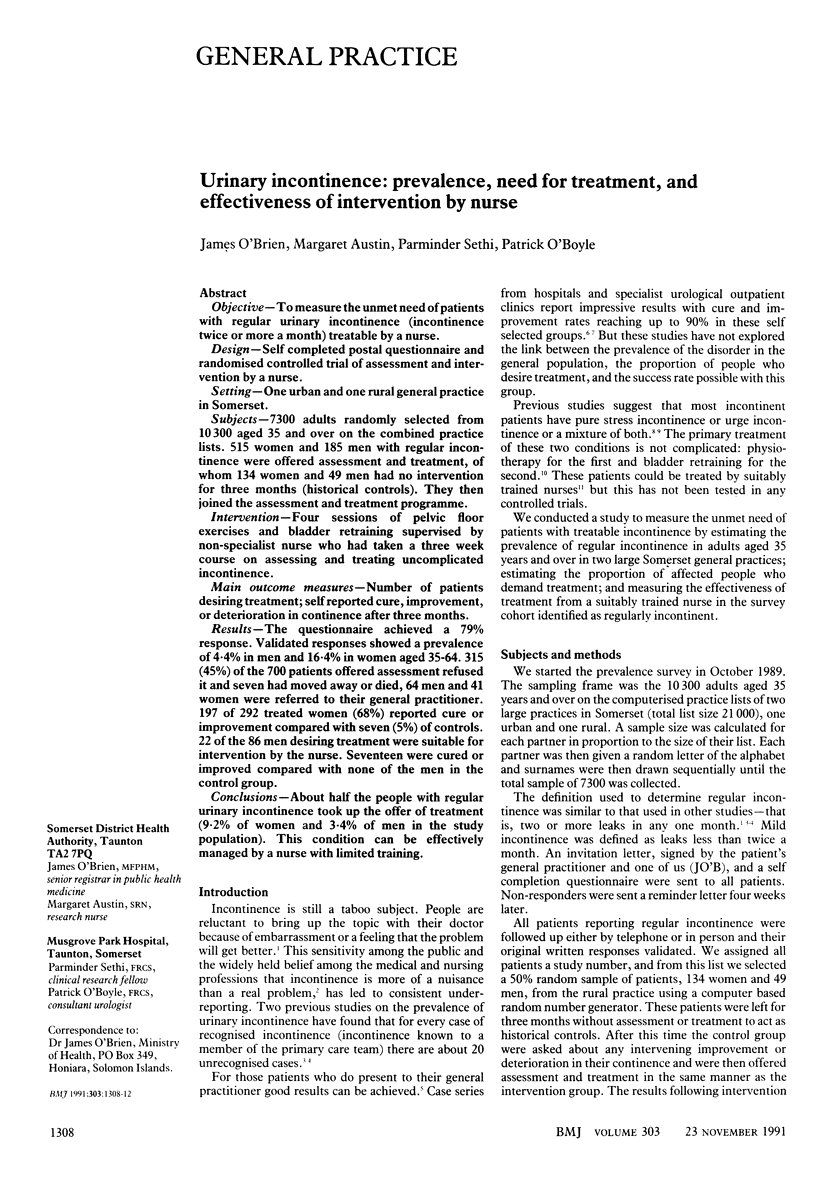
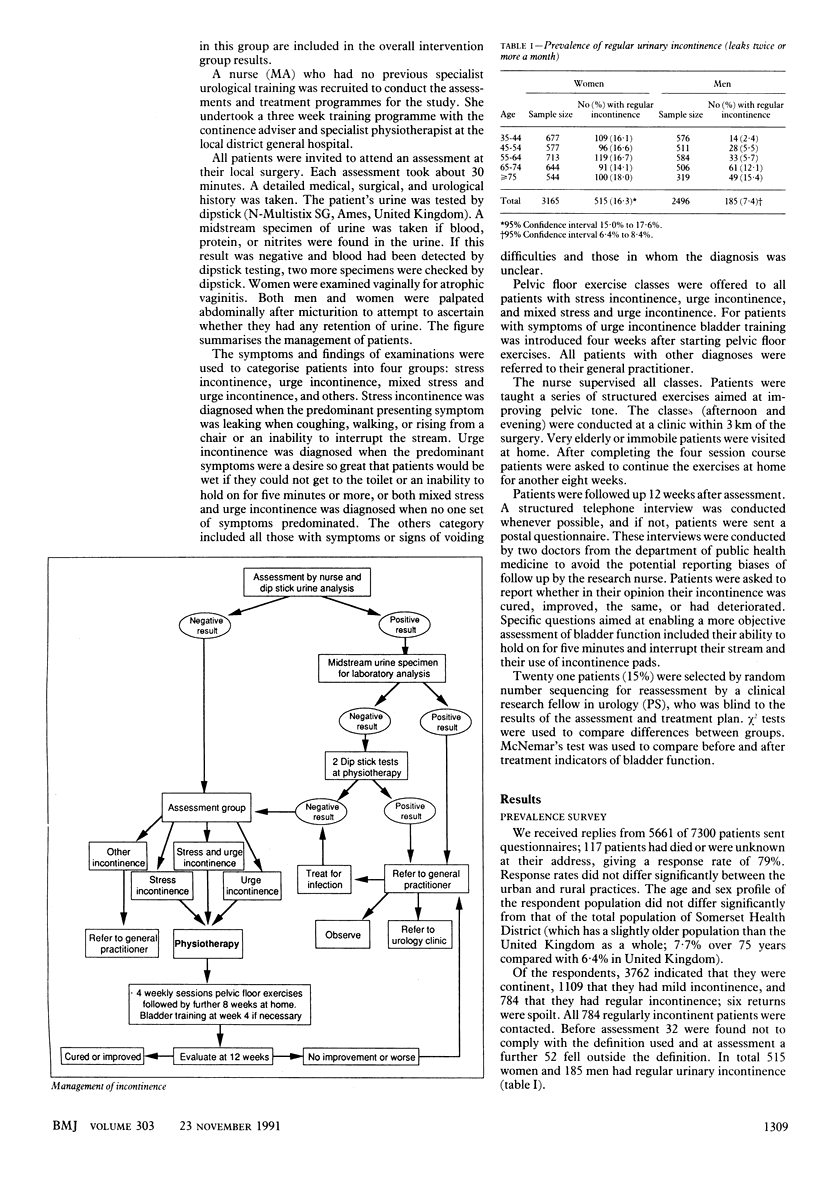
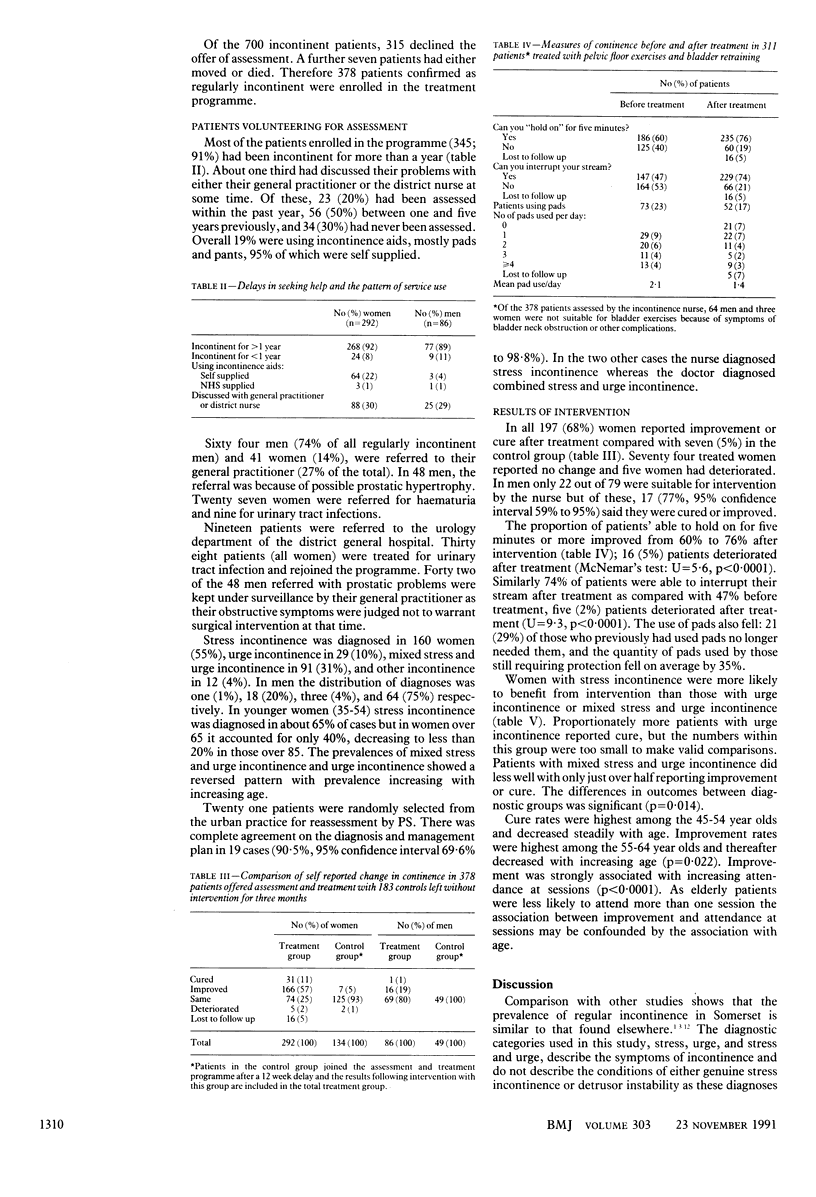
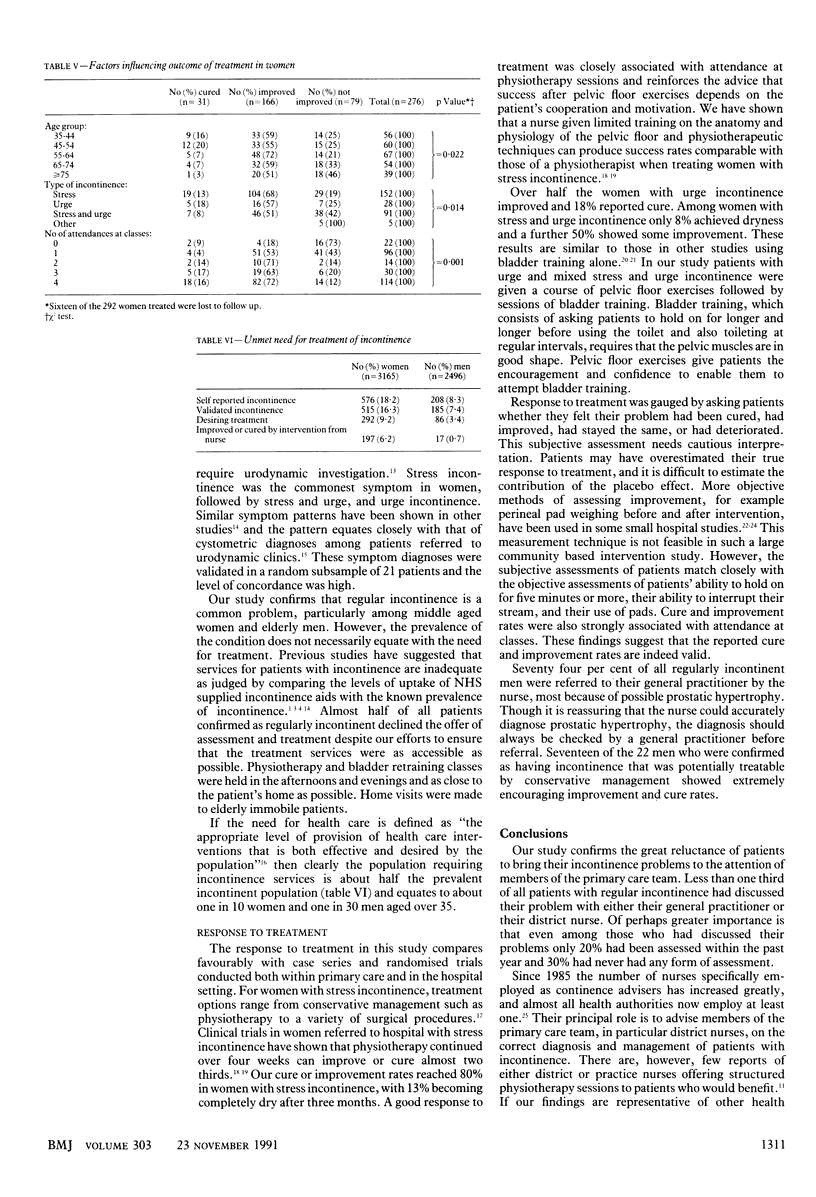
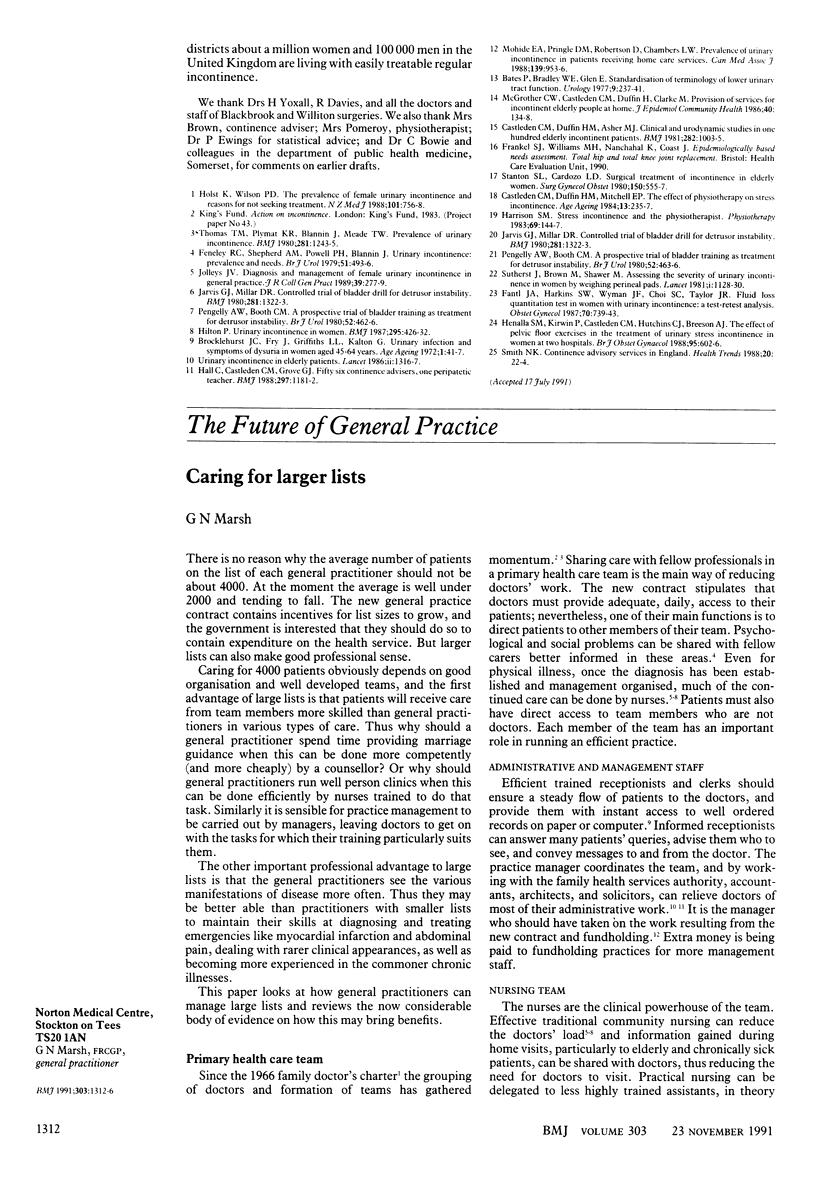
Selected References
These references are in PubMed. This may not be the complete list of references from this article.
- Castleden C. M., Duffin H. M., Mitchell E. P. The effect of physiotherapy on stress incontinence. Age Ageing. 1984 Jul;13(4):235–237. doi: 10.1093/ageing/13.4.235. [DOI] [PubMed] [Google Scholar]
- Fantl J. A., Harkins S. W., Wyman J. F., Choi S. C., Taylor J. R. Fluid loss quantitation test in women with urinary incontinence: a test-retest analysis. Obstet Gynecol. 1987 Nov;70(5):739–743. [PubMed] [Google Scholar]
- Feneley R. C., Shepherd A. M., Powell P. H., Blannin J. Urinary incontinence: prevalence and needs. Br J Urol. 1979 Dec;51(6):493–496. doi: 10.1111/j.1464-410x.1979.tb03585.x. [DOI] [PubMed] [Google Scholar]
- Hall C., Castleden C. M., Grove G. J. Fifty six continence advisers, one peripatetic teacher. BMJ. 1988 Nov 5;297(6657):1181–1182. doi: 10.1136/bmj.297.6657.1181. [DOI] [PMC free article] [PubMed] [Google Scholar]
- Harrison S. M. Stress incontinence and the physiotherapist. Physiotherapy. 1983 May 10;69(5):144–147. [PubMed] [Google Scholar]
- Henalla S. M., Kirwan P., Castleden C. M., Hutchins C. J., Breeson A. J. The effect of pelvic floor exercises in the treatment of genuine urinary stress incontinence in women at two hospitals. Br J Obstet Gynaecol. 1988 Jun;95(6):602–606. doi: 10.1111/j.1471-0528.1988.tb09491.x. [DOI] [PubMed] [Google Scholar]
- Hilton P. Urinary incontinence in women. Br Med J (Clin Res Ed) 1987 Aug 15;295(6595):426–432. doi: 10.1136/bmj.295.6595.426. [DOI] [PMC free article] [PubMed] [Google Scholar]
- Holst K., Wilson P. D. The prevalence of female urinary incontinence and reasons for not seeking treatment. N Z Med J. 1988 Nov 9;101(857):756–758. [PubMed] [Google Scholar]
- Jarvis G. J., Millar D. R. Controlled trial of bladder drill for detrusor instability. Br Med J. 1980 Nov 15;281(6251):1322–1323. doi: 10.1136/bmj.281.6251.1322-a. [DOI] [PMC free article] [PubMed] [Google Scholar]
- Jarvis G. J., Millar D. R. Controlled trial of bladder drill for detrusor instability. Br Med J. 1980 Nov 15;281(6251):1322–1323. doi: 10.1136/bmj.281.6251.1322-a. [DOI] [PMC free article] [PubMed] [Google Scholar]
- Jolleys J. V. Diagnosis and management of female urinary incontinence in general practice. J R Coll Gen Pract. 1989 Jul;39(324):277–279. [PMC free article] [PubMed] [Google Scholar]
- McGrother C. W., Castleden C. M., Duffin H., Clarke M. Provision of services for incontinent elderly people at home. J Epidemiol Community Health. 1986 Jun;40(2):134–138. doi: 10.1136/jech.40.2.134. [DOI] [PMC free article] [PubMed] [Google Scholar]
- Mohide E. A., Pringle D. M., Robertson D., Chambers L. W. Prevalence of urinary incontinence in patients receiving home care services. CMAJ. 1988 Nov 15;139(10):953–956. [PMC free article] [PubMed] [Google Scholar]
- Pengelly A. W., Booth C. M. A prospective trial of bladder training as treatment for detrusor instability. Br J Urol. 1980 Dec;52(6):463–466. doi: 10.1111/j.1464-410x.1980.tb03091.x. [DOI] [PubMed] [Google Scholar]
- Stanton S. L., Cardozo L. D. Surgical treatment of incontinence in elderly women. Surg Gynecol Obstet. 1980 Apr;150(4):555–557. [PubMed] [Google Scholar]
- Sutherst J., Brown M., Shawer M. Assessing the severity of urinary incontinence in women by weighing perineal pads. Lancet. 1981 May 23;1(8230):1128–1130. doi: 10.1016/s0140-6736(81)92299-6. [DOI] [PubMed] [Google Scholar]
- Thomas T. M., Plymat K. R., Blannin J., Meade T. W. Prevalence of urinary incontinence. Br Med J. 1980 Nov 8;281(6250):1243–1245. doi: 10.1136/bmj.281.6250.1243. [DOI] [PMC free article] [PubMed] [Google Scholar]


